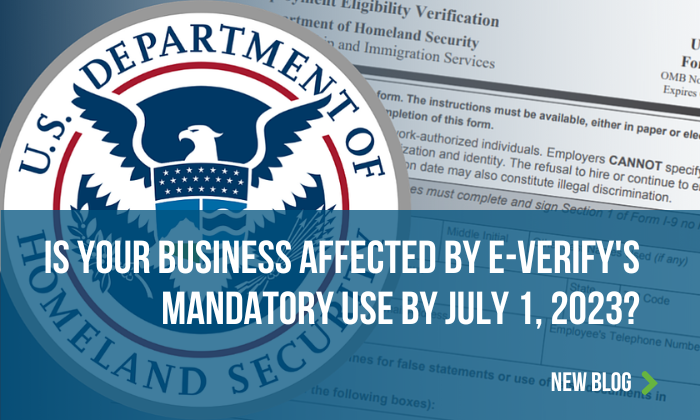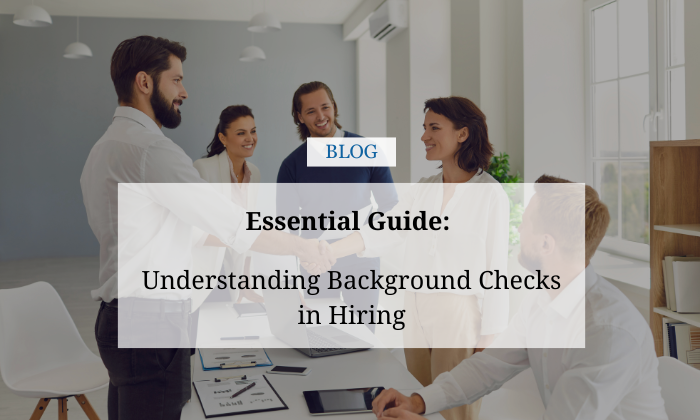E-Verify, the electronic employment verification system, has become a crucial tool for businesses to ensure the legal status of their employees. As of July 1, 2023, a significant change is on the horizon for employers across the United States. On this date, the mandatory use of E-Verify will be enforced, impacting businesses of various sizes and industries. If you’re a business owner or HR professional, it’s essential to understand the implications of this requirement and take necessary steps to ensure compliance.
E-Verify is an electronic employment verification system developed by the U.S. Department of Homeland Security (DHS) in partnership with the Social Security Administration (SSA). It serves as a valuable tool for employers to confirm the eligibility of their employees to work in the United States.
E-Verify works by comparing the information provided by employees on their Form I-9, such as their Social Security number and immigration documents, with data from DHS and SSA records. This verification process helps employers ensure that their workforce is composed of individuals who are authorized to work in the country.
The primary goal of E-Verify is to strengthen the integrity of the workforce by preventing unauthorized employment and protecting job opportunities for eligible workers. By using E-Verify, employers can actively contribute to maintaining a legal and compliant workforce while reducing the risk of hiring individuals who may be unauthorized to work.
It’s important to note that E-Verify is a voluntary program for most employers, except in cases where specific state legislation or federal contracts require its use. However, with the mandatory use requirement coming into effect on July 1, 2023, certain businesses will be obligated to utilize E-Verify as a part of their employment verification process.
The Mandatory Use Requirement
Effective July 1, 2023, a significant change will take place regarding the use of E-Verify. The U.S. government has mandated that certain businesses must utilize E-Verify as a part of their employment verification process. This requirement applies to employers in specific categories and industries.
The exact scope of businesses affected by the mandatory use requirement may vary based on state laws and federal regulations. Generally, it includes employers with federal contracts or subcontracts that contain the Federal Acquisition Regulation (FAR) E-Verify clause. Additionally, some states have implemented laws that expand the requirement to other businesses beyond federal contractors.
The purpose of this mandatory use requirement is to promote compliance with immigration laws, enhance the integrity of the workforce, and ensure job opportunities for authorized workers. By utilizing E-Verify, employers can verify the eligibility of their employees and maintain a workforce that meets the legal requirements.
Non-compliance with the mandatory use requirement can have serious consequences for businesses, including potential legal and financial penalties. It is crucial for affected employers to understand their obligations and take the necessary steps to ensure compliance with the mandated use of E-Verify.
Understanding the Impact on Businesses
The mandatory use of E-Verify by July 1, 2023, carries several implications for affected businesses. It’s crucial to grasp these potential impacts to effectively navigate the transition and ensure compliance with the requirement. Here are key factors to consider:
1. Hiring and Employment Practices:
Implementing E-Verify as a mandatory part of the employment verification process will require adjustments to hiring practices. Employers will need to integrate E-Verify into their onboarding procedures and ensure that all new hires undergo the verification process within the required timeframe.
2. Administrative Burden:
The mandatory use of E-Verify may introduce an additional administrative burden for businesses. It involves learning the system, training HR staff on its usage, and incorporating it seamlessly into existing HR processes. Adequate preparation and training will be necessary to ensure a smooth transition and minimize any potential disruptions.
3. Compliance Challenges:
Complying with the mandatory use requirement necessitates staying up-to-date with relevant laws, regulations, and system updates. Businesses must familiarize themselves with the specific requirements applicable to their industry and geographic location. This includes understanding federal and state guidelines, tracking any changes, and ensuring ongoing compliance.
4. Potential Workflow Impact:
Depending on the size and nature of the business, incorporating E-Verify as a mandatory step in the hiring process may impact workflow and timelines. Employers should anticipate potential adjustments to the hiring timeline and ensure that sufficient resources are allocated to accommodate any changes.
5. Employer-Employee Relationship:
Introducing E-Verify may raise questions and concerns among employees. Transparent communication and educating employees about the purpose and process of E-Verify can help alleviate any apprehensions and maintain a positive employer-employee relationship.
Steps to Ensure Compliance
To ensure compliance with the mandatory use of E-Verify by July 1, 2023, affected businesses can follow these essential steps:
1. Understand the Requirements:
Familiarize yourself with the specific requirements applicable to your business. Research federal laws, state regulations, and any industry-specific guidelines related to the mandatory use of E-Verify. This will help you gain clarity on the obligations and responsibilities you need to fulfill.
2. Register for E-Verify:
If you haven’t already done so, register your business for E-Verify. Visit the official E-Verify website and follow the registration process. Provide the necessary information about your business, including employer identification details, to create an E-Verify account.
3. Integrate E-Verify into HR Processes:
Incorporate E-Verify seamlessly into your HR processes to ensure a smooth verification workflow. Train your HR staff on how to use the system effectively, including entering employee information, interpreting verification results, and resolving any potential issues that may arise during the process.
4. Educate Employees:
Inform your employees about the implementation of E-Verify and its purpose. Clearly communicate the steps involved in the verification process, reassure them of the confidentiality and security of their personal information, and address any concerns they may have. Employee understanding and cooperation are essential for successful implementation.
5. Audit and Monitor Compliance:
Establish a system for regularly auditing and monitoring E-Verify compliance within your organization. Conduct periodic internal audits to ensure proper usage, accurate record-keeping, and adherence to the mandatory use requirement. Address any non-compliance issues promptly and take corrective actions as necessary.
6. Stay Updated:
Stay informed about changes, updates, and enhancements related to E-Verify and the mandatory use requirement. Subscribe to official E-Verify newsletters, follow relevant government websites, and join industry groups or forums to receive the latest information. Remaining up-to-date will help you adapt to any regulatory changes effectively.
7. Seek Professional Guidance if needed.
If you have specific concerns or complex situations related to the mandatory use of E-Verify, consider seeking professional guidance. Consult with immigration attorneys, HR experts, or consultants experienced in employment verification to ensure you are fully compliant and mitigate any potential risks.
Addressing Concerns and Misconceptions
The mandatory use of E-Verify may give rise to concerns and misconceptions among businesses. It’s important to address these apprehensions and provide accurate information to foster a better understanding of the requirement. Here are some common concerns and misconceptions surrounding E-Verify:
1. Employee Privacy:
Concern: Employees may worry about the privacy of their personal information and how it is handled within the E-Verify system.
Address: Assure employees that E-Verify is designed to protect their privacy. The system uses secure encryption methods to transmit data and complies with privacy laws. Emphasize that personal information is used solely for employment verification purposes and is not shared or used for other purposes.
2. System Complexity:
Concern: Employers may perceive E-Verify as a complex and time-consuming system to implement and use.
Address: Highlight the availability of training resources and user-friendly interfaces provided by E-Verify. Explain that the system is designed to streamline the employment verification process and, with proper training and familiarization, it can become an efficient part of the HR workflow.
3. Legal Compliance:
Concern: Businesses may have concerns about whether they can navigate the complex web of federal and state regulations to ensure compliance with the mandatory use requirement.
Address: Encourage businesses to stay updated on the latest regulations and seek guidance from legal professionals, HR experts, or consultants specializing in employment verification. Clarify that compliance is achievable with the right resources and support.
4. Impact on the Hiring Process:
Concern: Employers may worry about potential delays or disruptions to their hiring process due to the implementation of E-Verify.
Address: Provide guidance on how to seamlessly integrate E-Verify into the hiring process to minimize disruptions. Emphasize the importance of proper training, the allocation of resources, and clear communication with candidates to ensure a smooth transition.
5. False Positives or Errors:
Concern: Employers may be concerned about the possibility of false positives or errors during the verification process, leading to complications or incorrect results.
Address: Explain that E-Verify utilizes multiple data sources and verification methods to minimize errors. Encourage employers to follow proper procedures for resolving Tentative Non-Confirmation (TNCs) and provide guidance on how to address any discrepancies or issues that may arise during the verification process.
Resources and Support for Businesses
When navigating the mandatory use of E-Verify, businesses can leverage various resources and support systems to ensure a smooth transition and compliance. Here are some valuable resources and avenues of support:
1. E-Verify Website:
The official E-Verify website serves as a comprehensive resource hub. It provides a wealth of information, including user manuals, guides, training materials, and FAQs. Explore the website to access the latest resources and stay updated on any changes or announcements.
2. Helpdesk and Customer Support:
E-Verify offers a dedicated helpdesk and customer support services to assist businesses with their inquiries and concerns. Reach out to the E-Verify Help Desk via phone or email to receive guidance, clarification, and technical assistance related to using the system and ensuring compliance.
3. Training Materials and Webinars:
E-Verify regularly conducts webinars, online tutorials, and training sessions to help employers understand the system and its usage. Take advantage of these training opportunities to educate HR staff, managers, and employees on proper E-Verify procedures, compliance requirements, and best practices.
4. Government Agencies:
Federal agencies such as the U.S. Department of Homeland Security (DHS) and the U.S. Citizenship and Immigration Services (USCIS) can provide additional guidance and support. Explore their websites and contact their offices for information on E-Verify regulations, compliance assistance, and any specific industry-related guidelines.
5. Professional Associations and Industry Groups:
Joining professional associations or industry-specific groups can offer valuable networking opportunities and access to resources related to E-Verify. These organizations often provide guidance, workshops, and forums where businesses can connect with experts and share best practices.
6. Legal and HR Professionals:
Consult with immigration attorneys, HR experts, or consultants who specialize in employment verification and compliance. These professionals can provide personalized guidance tailored to your specific business needs and help navigate complex legal and regulatory requirements.
Conclusion
As the mandatory use of E-Verify approaches, businesses must proactively prepare for this significant change in employment verification requirements. Understanding the impact of this requirement and taking necessary steps to ensure compliance is crucial for maintaining a legal and authorized workforce. By embracing the use of E-Verify, businesses can contribute to the integrity of the workforce, protect job opportunities for eligible workers, and mitigate the risks associated with unauthorized employment.
While navigating the mandatory use of E-Verify may present challenges, businesses can rely on the available resources, support systems, and professional guidance to ease the transition.
Embracing compliance with the mandatory use requirement will not only help businesses meet legal obligations but also foster a culture of accountability and trust within the organization. By prioritizing compliance, businesses can build a strong foundation for success in a changing regulatory landscape and contribute to a more robust and law-abiding workforce ecosystem.







